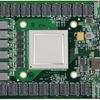This week Russia posted its list of the 50 most powerful supercomputing systems installed in the country. From the looks of things, not much is happening in the HPC space there. System turnover across the Top50 during the last six months was minimal and aggregate performance barely budged.
Although Googles Tensor Processing Unit (TPU) has been powering the companys vast empire of deep learning products since 2015, very little was known about the custom-built processor. This week the web giant published a description of the chip and explained why its an order of magnitude faster and more energy-efficient than the CPUs and GPUs it replaces.
Ministers from seven European countries have signed on to a plan to develop an exascale capability based on technology developed within the EU member states. The goal is to bring up two pre-exascale supercomputers by 2020 and two full exascale systems no later than 2023.
In November 2015 when NVIDIA CEO Jen-Hsun Huang proposed that machine learning is high performance computings first killer app for consumers, there was only sketchy evidence to back up that claim. Today though, it looks like the NVIDIA chief was just a little ahead of his time.
This week in San Francisco, Intel held its first Manufacturing and Technology Day, an event designed to reassure investors and customers that Moores Law is alive and well and delivering the cost and performance benefits it has for the last 50 years. However, to make that claim viable, the chipmaker has recast the law to deal with the realities of a slowdown in transistor shrinkage.
The Engineering and Physical Sciences Research Council (EPSRC) has allocated 20 million for six new tier 2 supercomputing centers spread across the United Kingdom. The facilities are aimed at supporting both academic and industrial users and will house medium-sized supercomputers for scientific research and engineering.
As China, the US and Japan near the finish line in exascale race, the DOE and NSA are sounding the alarm that the United States is at grave risk of losing its dominant position in high performance computing. According to the assessment of the two agencies, absent aggressive action by the US the US will lose leadership and not control its own future in HPC.
The long-predicted demise of Moores Law appears to be playing out. Over the last couple of years, Intel and other chipmakers have struggled to keep their semiconductor technology plans on schedule, paving the way for fundamental changes in the computer industry.
Applied Micro announced it is sampling X-Gene 3, its third-generation ARM SoC for servers. According to a report by The Linley Group, the new platform will provide comparable performance to the latest Intel Xeon processors, but at a significantly lower price point.
AMD announced this week it will being shipping its new Naples server CPU in the second quarter of 2017, hoping to disrupt Intels hegemony in the server market. The upcoming chip looks to be the first CPU from AMD to offer a credible challenge to Xeon in the datacenter in nearly a decade.










